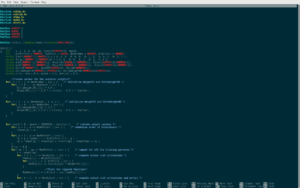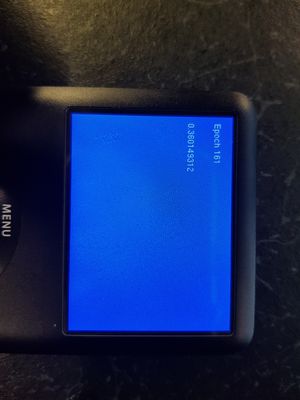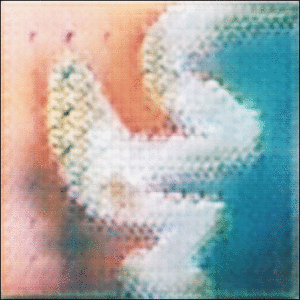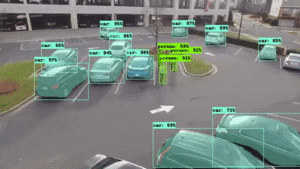User:Alexander Roidl/new-new-new-new-projectproposal
What do you want to make?
There is a lot of attention towards Artificial Intelligence and its implications, but there is small research about the algorithms and software itself, other than from an engineering point of view. So in the manner of Software Art or Software Studies this work doesn’t want to make an easy critique of A.I. or create magical applications but rather take the neural network as its primary object of study. So instead by concentrating on inner concepts and its architecture I want to find a different approach towards machine learning. So with my work I wish to create a comment that is very much focused on the algorithm itself rather then adding more to the recent questions about A.I. intervening in our daily life. Of particular interest within this framework of machine learning are neural networks that adapt certain human features like learning and neurons. This architecture brings certain consequences in terms of resources, regarding computing power and data. Like in my written thesis this work follows up on the concept of Software Art and provides a work that is rather focusing on process then on outcome. It might take the form of an installation, funware, software or even a platform for discussion, including a documentation of the process. Through learning the fundamentals of neural networks I want to intervene in their inner working and therefore create a work expressing the deeper semiotics of those algorithms. I plan to make experiments going along with the research that will eventually accumulate to one final work. This is always accompanied by the question: Do these algorithms (neural networks) have the potential for deeper artistic engagement that is beyond »A.I. magic« (using A.I. as a tool to generate surprising but rather meaningless output)?
How do you plan to make it?
I will learn about the inner workings of machine learning, and especially machine learning algorithms with a focus on neural networks. Software Art provides an interesting approach towards existing engagement with AI in the arts. In that sense I want to put the process and the cultural meaning in my focus rather than the outcome itself, which is the case now with existing works that use machine learning as their main medium or tool:
- https://www.christies.com/features/A-collaboration-between-two-artists-one-human-one-a-machine-9332-1.aspx
- https://news.artnet.com/market/google-inceptionism-art-sells-big-439352
- https://www.3ders.org/articles/20141130-3d-printed-face-masks-defy-surveillance-technology.html
The high level of frameworks that allow simple implementation of machine learning in applications blurs the core ideas of the algorithm and abstracts it to a magical black box. I want to unravel that by researching on the basic structures of neural networks.
I started with writing a basic neural network in C and installed it on an iPod as a first prototype thinking about resources and the complex structures that are hidden in high level approaches.
What is your timetable?
Along the writing of the thesis which will be based on careful reading and research, I want to make experiments with basic structures of neural networks.
Basic outline of planning
- October / November: Frame work + outline, research on machine learning and software arts.
- December: Further research on machine learning algorithms and their inner workings. Starting with more elaborate prototyping, intervening in the structure.
- January: Deeper Research and writing on Software Art and the implications of new machine learning algorithms.
- February: Further research and writing + prototyping. Maybe test the prototypes with an audience.
- March: Finish and finetune writing. Translate prototypes into final project.
- April / Mai / June: Finish & fine-tune final project.
Why do you want to make it?
Online you constantly see news about new machine learning algorithms. I encountered a lot of technical papers in the past, where technicians are talking about creative applications of A.I..
To widen the field of machine learning algorithms. It is not only part of software development, where it is used as a pure tool, or marketing, or simple image generation.
Who can help you and how?
- PZI Tutors > Research / Prototyping
- AI Now Institute https://ainowinstitute.org/ I reached out to them and hope to be able to get some insights in their research about the social impact of artificial intelligence
- XPUB Gang
- Interaction Station: Javier (They are researching about machine learning in creative practices right now)
- V2 AI-Lab? (Although their understanding of AI in the field of Arts seems different)
Relation to previous practice
As a designer and artist I worked quite intensively on computational structures, including algorithms, networks and databases. In addition to that I gained interest in new media and technology that would enhance humans. I am interested in understanding these new phenomena and their effects. Furthermore I became interested in the hype around machine learning and I already did a few experiments that were related to experimental creative use of machine learning. Without prior knowledge of machine learning I generated new images of coastlines out of an accumulated dataset.
After further engagement I realised that these kinds of experiments didn’t really have a further relevance and can be found all over the net, following the hype around artificial intelligence. So with my work I want to find a way to further investigate on these new kinds of algorithms and integrate them in my artistic practice in a meaningful and lasting way.
Relation to a larger context
Nowadays machine learning is embedded in many contemporary digital systems that drive our world. These systems and models of machine learning are really hard to understand, to the level where even the creator of such algorithms is not even able to have an insight, why machines make certain decisions. New methods of machine learning have also found their way into the arts, where the latter are trying to make sense out of these new algorithms. They are focusing on the outcomes and consequences of machine learning, but there is no interaction with the inner workings of these algorithms, how we see it the realm of Software Art for instance. These algorithms also burry a potential for artistic study and even poetics. It is important to understand these systems and their implications in order to be able to influence them.
References
Literature (most important selection)
- Benjamin, W. (2008). The Work of Art in the Age of Mechanical Reproduction. London: Penguin.
- Berger, J. (2008). Ways of Seeing (01 edition). London: Penguin Classics.
- Bridle, J. (2018). New Dark Age: Technology and the End of the Future. London ; Brooklyn, NY: Verso.
- Broeckmann, A. (2006). Software Art Aesthetics. Retrieved 11 November 2018, from http://www.mikro.in-berlin.de/wiki/tiki-index.php?page=Software+Art
- Burrell, J. (2016). How the machine ‘thinks’: Understanding opacity in machine learning algorithms. Big Data & Society, 3(1), 2053951715622512. https://doi.org/10.1177/2053951715622512
- Charly Onrop. (n.d.). TV Doku Spiegel Unberechenbarkeit 1/3. Retrieved from https://www.youtube.com/watch?v=AavTap5FgSQ&feature=youtu.be&t=275
- Cox, G. (2007). ‘Generator: The Value of Software Art’, in Rugg, J., & Sedgwick, M. (ed.) Issues in Curating Contemporary Art and Performance. Intellect Books, pp. 147-162.
- Deep Angel, The Artificial Intelligence of Absence. (n.d.). Retrieved 1 November 2018, from http://deepangel.media.mit.edu/
- Finn, E. (2017). What Algorithms Want: Imagination in the Age of Computing. Cambridge, MA: The MIT Press.
- Flusser, V. (2011). Into the Universe of Technical Images. (N. A. Roth, Trans.) (1 edition). Minneapolis: Univ Of Minnesota Press.
- Gere, C. (2008). Digital Culture (2nd Revised edition edition). London: Reaktion Books.
- Gerstner, K. (2007). Karl Gerstner: Designing Programmes (3., rd, and enlarged ed.). Baden: Lars Müller.
- Haridy, R. (2018). Adobe’s new AI can identify altered images. Retrieved 1 November 2018, from https://newatlas.com/adobe-ai-detect-image-manipulation/55179/
- Hoelzl, I., & Marie, R. (2015). Softimage: Towards a New Theory of the Digital Image. Bristol: Intellect Ltd.
- Hu, T.-H. (2016). A Prehistory of the Cloud (Reprint edition). Cambridge, Massachusetts: The MIT Press.
- Mitchell, W. J. T. (1980). The Language of Images (Reprint edition). Chicago: University of Chicago Press Journals.
- Müller, A. C., & Guido, S. (2016). Introduction to Machine Learning with Python: A Guide for Data Scientists (1 edition). Sebastopol, CA: O’Reilly Media.
- Postdigital Aesthetics - Art, Computation And Design | D. Berry | Palgrave Macmillan. (n.d.). Retrieved from //www.palgrave.com/gp/book/9781137437198
- Press, T. M. (n.d.). The Allure of Machinic Life. Retrieved 15 October 2018, from https://mitpress.mit.edu/books/allure-machinic-life
Relations
- In 2012 James Bridle established the term »New Aesthetic« in 2012, an ongoing collection of images on a tumblr blog.




